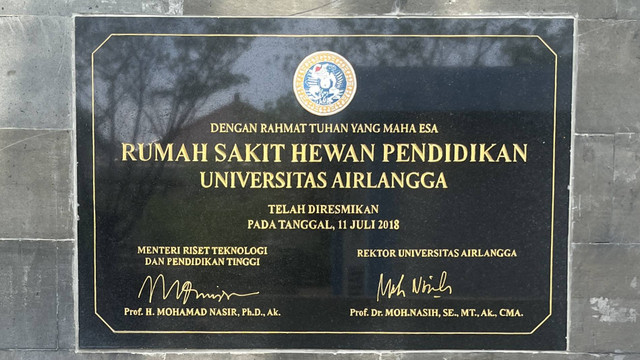Tentang KamiPedoman Media SiberKetentuan & Kebijakan PrivasiPanduan KomunitasPeringkat PenulisCara Menulis di kumparanInformasi Kerja SamaBantuanIklanKarir
2025 © PT Dynamo Media Network
Version 1.102.2
Konten dari Pengguna
Observations from the Veterinary Field
11 Desember 2024 13:26 WIB
·
waktu baca 5 menitTulisan dari Farisha sofia tidak mewakili pandangan dari redaksi kumparan

ADVERTISEMENT
ADVERTISEMENT
Veterinary Services Overview
In veterinary medicine, this skill is vital for diagnosing illnesses, developing treatment plans, and communicating effectively with pet owners. Officers at RSUHA are trained to think critically, enabling them to navigate complex situations and provide optimal care for animals. RSUHA offers a wide range of veterinary services, including consultations, surgeries, diagnostics, and emergency care. Each officer specializes in different areas, such as surgery, internal medicine, and exotic animal care, ensuring that each animal receives expert attention.
Service Activities
During consultations, veterinary officers assess the animal's health through physical examinations and detailed discussions with pet owners. The communication here is critical. Officers use both verbal and non-verbal cues to establish rapport and gather necessary information. First is questioning Techniques. As my observation in RSUHA, veterinary officers utilize open-ended questions to encourage pet owners to share detailed information. For instance, instead of asking, "Is your pet eating less?" they might ask, "Can you describe your pet's eating habits over the past few days?" This approach allows officers to gather richer data, which is crucial for accurate diagnosis. After that logical deduction, once information is collected, officers analyze the data to identify patterns or anomalies. For example, if a dog presents with lethargy and vomiting, the officer might consider various underlying conditions ranging from dietary indiscretion to more severe issues like pancreatitis. This logical deduction is essential for formulating a differential diagnosis.
ADVERTISEMENT
Diagnostics
The diagnostic phase involves the use of various tools and tests to confirm or rule out potential health issues. Here, critical thinking manifests in several ways. Interpreting results as a veterinary officers must interpret lab results and imaging studies critically. For instance, an elevated white blood cell count may indicate an infection, but it could also suggest stress or inflammation. Officers must weigh all possibilities before arriving at a conclusion, demonstrating logical reasoning in their analytical process. Decision Making is Based on diagnostic findings, officers decide on the next steps whether to treat the condition immediately, refer the pet to a specialist, or monitor the situation closely. This decision making process requires evaluating the risk and benefits of each option, showcasing critical thinking in action.
ADVERTISEMENT
Surgical Procedures
Surgical interventions present unique challenges that necessitate high levels of critical thinking. Preoperative planningis important before surgery, officers must assess the risks associated with the procedure and the animal's health status. This involves logical reasoning to evaluate factors such as age, breed, and pre-existing conditions. For example, an older dog with heart disease may require additional precautions during anesthesia, influencing the surgical approach. Intraoperative decisions during surgery, the ability to think critically is paramount. Unexpected complications can arise, requiring officers to quickly evaluate the situation and adjust their techniques accordingly. For instance, if unexpected bleeding occurs, the officer must decide whether to continue the procedure or stabilize the animal first.
ADVERTISEMENT
Emergency Care
The highstakes environment of emergency care requires rapid, yet thoughtful decision-making. Rapid Assessment, In emergencies, officers must quickly assess an animal's condition and prioritize interventions. By applying critical thinking, they can identify life-threatening issues (e.g., shock, severe trauma) that require immediate attention. Multidisciplinary communication emergency situations often involve a team of veterinary professionals. Effective communication is vital for coordinating care. Officers must articulate their observations and decisions clearly, ensuring that all team members are aligned in their approach. This requires logical structuring of information, as well as the ability to listen and respond to others' inputs.
Types of Communication in Veterinary Services
Verbal Communication
as a clarity and Precision in veterinary officers must communicate complex medical information clearly to pet owners. This involves simplifying technical jargon without losing essential details. For example, explaining a treatment plan in layman's terms helps owners understand their pets' needs. Empathetic Communication. The emotional aspect of veterinary care cannot be overlooked. Officers often deal with anxious pet owners. Employing empathetic language, such as reassuring phrases and supportive comments that can alleviate stress and foster a collaborative relationship.
ADVERTISEMENT
Non-Verbal Communication
Such as a body language non-verbal cues play a significant role in veterinary practice. Officers use open body language to create a welcoming atmosphere. For instance, leaning slightly forward during a conversation indicates attentiveness and engagement, which can help build trust. other than that is facial expression. A veterinary officer's facial expressions can convey understanding and empathy. A gentle smile or a concerned look can reassure pet owners that their pets are in good hands, underscoring the importance of emotional intelligence in communication. Lastly a Gestures. Simple gestures, such as nodding to confirm understanding or using hand movements to demonstrate a procedure, reinforce verbal messages and enhance clarity. These non-verbal signals can make communication more effective, particularly in high-pressure situations.
ADVERTISEMENT
Paus Fransiskus wafat di usia 88 tahun pada Senin pagi (21/4) akibat stroke dan gagal jantung. Vatikan menetapkan Sabtu (26/4) sebagai hari pemakaman, yang akan berlangsung di alun-alun Basilika Santo Petrus pukul 10.00 pagi waktu setempat.

